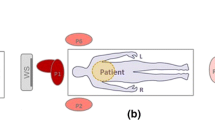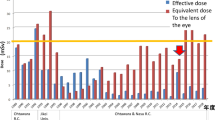Abstract
The main effect of ionizing radiation on the eyes is the onset of posterior cortical and subcapsular cataracts. Recent studies have raised questions about the mechanism of ocular damage and the threshold dose for the onset of such effects. Currently, operators may be exposed to ionizing radiation during surgical procedures. It has been estimated that urologists can be exposed to an annual dose close to or above 20 mSv/year. The aim of our study was to evaluate the frequency of cataracts in a group of professional radiological operators to verify their possible association with the radiation dose to the crystalline lens and the tasks performed. The records of 73 health workers exposed to ionizing radiation were reviewed. The average annual dose to the crystalline lens, the number of years of exposure, and the presence of radiation-compatible opacities were assessed for all operators. Lenticular opacities were observed in 16.4% of subjects. The presence of alterations was associated with exposure doses below 10 mSv and > 10 years’ experience in fluoroscopically guided procedures. Based on our results, protection of the crystalline lens against exposure to ionizing radiation by means of goggles is recommended. In addition, examination of the lens via slit lamp examination is recommended for all operators involved in interventional procedures with the current levels of radiation exposure.

Similar content being viewed by others
References
Minamoto TH, Yokoyama NS, Yoshitani Kumagami Mukai T, et al. Cataract in atomic bomb survivors. Int J Radiat Biol. 2004;80(5):339–45. https://doi.org/10.1080/09553000410001680332.
Nakashima E, Neriishi K, Minamoto. A reanalysis of atomic-bomb cataract data, 2000–2002. Health Phys. 2006;90(2):154–60.
Blakely EA, Kleiman NJ, Chodick G, Neriishi K, Chylack LT, Cucinotta FA, Kumgami T, Kitaoka T, Kanamoto T, Kiuche Y, Chang P, Fujii N, King S. Radiation cataractogenesis: epidemiology and biology. Radiat Res. 2010;173(5):709–17.
Blakely EA, Lauriston S. Taylor lecture on radiation protection and measurements: what makes particle radiation so effective? Health Phys. 2012;103(5):508–28.
Ainsbury EA, Boeffler SD, Dorr W, Graw J, Muirhead CR, Edwards AA, Cooper J. Radiation cataractogenesis: a review of recent studies. Radiat Res. 2009;172(1):1–9.
Dauer A, Dynlacht EA, Lt J, et al. Status of NCRP scientific committee 1–23 commentary on guidance on radiation dose limits for the lens of the eye. Health Phys. 2016;110(2):182–4. https://doi.org/10.1097/HP.0000000000000412.
Cousins C, Miller DL, Bernards G, Rehani MM, Schofield P, Vañó A, Einstein AJ, Geiger B, Heintz PR, Sim KH. ICRP publication 120: radiological protection in cardiology; international commission on radiological protection. Ann ICRP. 2013; 42(1):1–125. https://doi.org/10.1016/j.icrp.2012.09.001.
Auvinen A, Kivelä T, Heinävaara S, Gertrude S. Eye lens opacities among physicians occupationally exposed to ionizing radiation. Ann Occup Hyg. 2015; 59(7): annhyg. https://doi.org/10.1093/945-8./mev022 (EPUB 2015 Apr 13).
Vano E, Kleiman NJ, Duran A, Romano-Miller M, Rehani MM. Radiation-associated lens opacities in catheterization personnel: results of a survey and direct assessments. J Vasc Interv Radiol. 2013;24(2):197–204. https://doi.org/10.1016/j.jvir.2012.10.016. (EPUB 2013 Jan 28).
Elmaraezy A, Ebraheem Morra M, Tarek Mohammed A, Elgebaly A, Abdelmotaleb Al-Ghazy Habaa A, Khalil A, Tien Huy AM, Hirayama N. K. Risk of cataract among cardiologists and interventional catheterization lab staff: a systematic review and meta-analysis. Catheter Cardiovasc Interv. 2017;90(1):1–9. https://doi.org/10.1002/ccd.27114 (EPUB 2017 May 13).
Haga Y, Chida K, Kaga Y, Sota M, Meguro T, Zuguchi M. Occupational eye dose in interventional cardiology procedures. Sci Rep. 2017;7(1): s41598. https://doi.org/10.1038/569.-017-00556-3.
Taylor ER1, Kramer B, Frye TP, Wang S, Schwartz BF, Köhler TS. Ocular radiation exposure in modern urological practice. J Urol. 2013;190 (1):139–43. https://doi.org/10.1016/j.juro.2013.01.081 (EPUB 2013 Jan 30).
Stewart DOES, Akleyev AV, Hauer-Jensen M, Hendry JH, Kleiman NJ, Macvittie TJ, Aleman BM, Edgar AB, Mabuchi K, Muirhead CR, Shore KING, Wallace WH.. ICRP publication 118: ICRP statement on tissue reactions and early and late effects of radiation in normal tissues and organs–threshold doses for tissue reactions in a radiation protection context. Ann ICRP. 2012; 41 (1–2): 1–322. https://doi.org/10.1016/j.icrp.2012.02.001.
Bencić G, Zorić-Geber M, Sarić D, Corak M, Mandić Z. Clinical importance of the lens opacities classification system III (LOCS III) in phacoemulsification. Coll Antropol. 2005;29(Suppl 1):91–4.
Ciraj-Bjelac OR, Galina M, Minamoto IN, Sim KH, Liew HB. Compartment and radiation-induced eye lens changes and risk for cataract in interventional cardiology. Cardiology. 2012;123(3):168–71. https://doi.org/10.1159/000342458 (EPUB 2012 Oct 31).
Jacob S, Boveda S, Or B, Brézin T, Ati MC, Laurier D, Bernier MO. Interventional cardiologists and risk of radiation-induced cataract: results of a multicenter observational study French. Int J Cardiol. 2013;167(5):1843–7. https://doi.org/10.1016/j.ijcard.2012.04.124. (EPUB 2012 May 18).
Vano E, Kleiman NJ, Duran A, Rehani MM, Echeverri D, Cabrera M. Radiation cataract risk in interventional cardiology. Radiat Res. 2010; 174 (4):490–5. https://doi.org/10.1667/RR2207.1.
Hamada N. Ionizing radiation response of primary normal human lens epithelial cells. PLoS One 2017;12(7):e0181530. https://doi.org/10.1371/journal.0181530.
Author information
Authors and Affiliations
Corresponding author
Ethics declarations
Conflict of interest
Authors declares that they no conflict of interests.
Ethical approval
All procedures performed in studies involving human participants were in accordance with the ethical standards of the institutional and/or national research committee and with the 1964 Helsinki declaration and its later amendments or comparable ethical standards. This article does not contain any studies with animals performed by any of the authors.
Informed consent
Informed consent was obtained from all individual participants included in the study.
About this article
Cite this article
Coppeta, L., Pietroiusti, A., Neri, A. et al. Risk of radiation-induced lens opacities among surgeons and interventional medical staff. Radiol Phys Technol 12, 26–29 (2019). https://doi.org/10.1007/s12194-018-0487-9
Received:
Revised:
Accepted:
Published:
Issue Date:
DOI: https://doi.org/10.1007/s12194-018-0487-9




